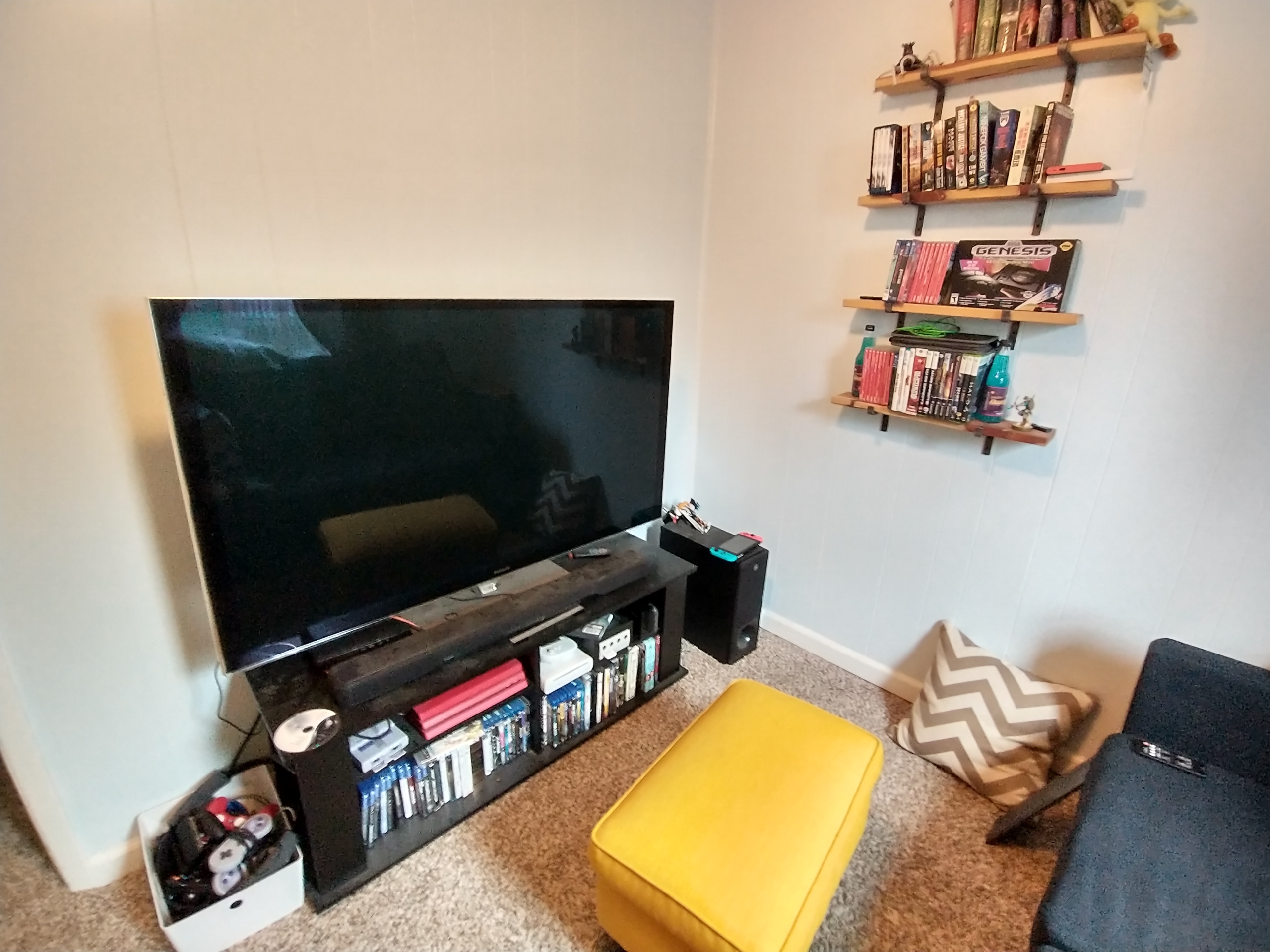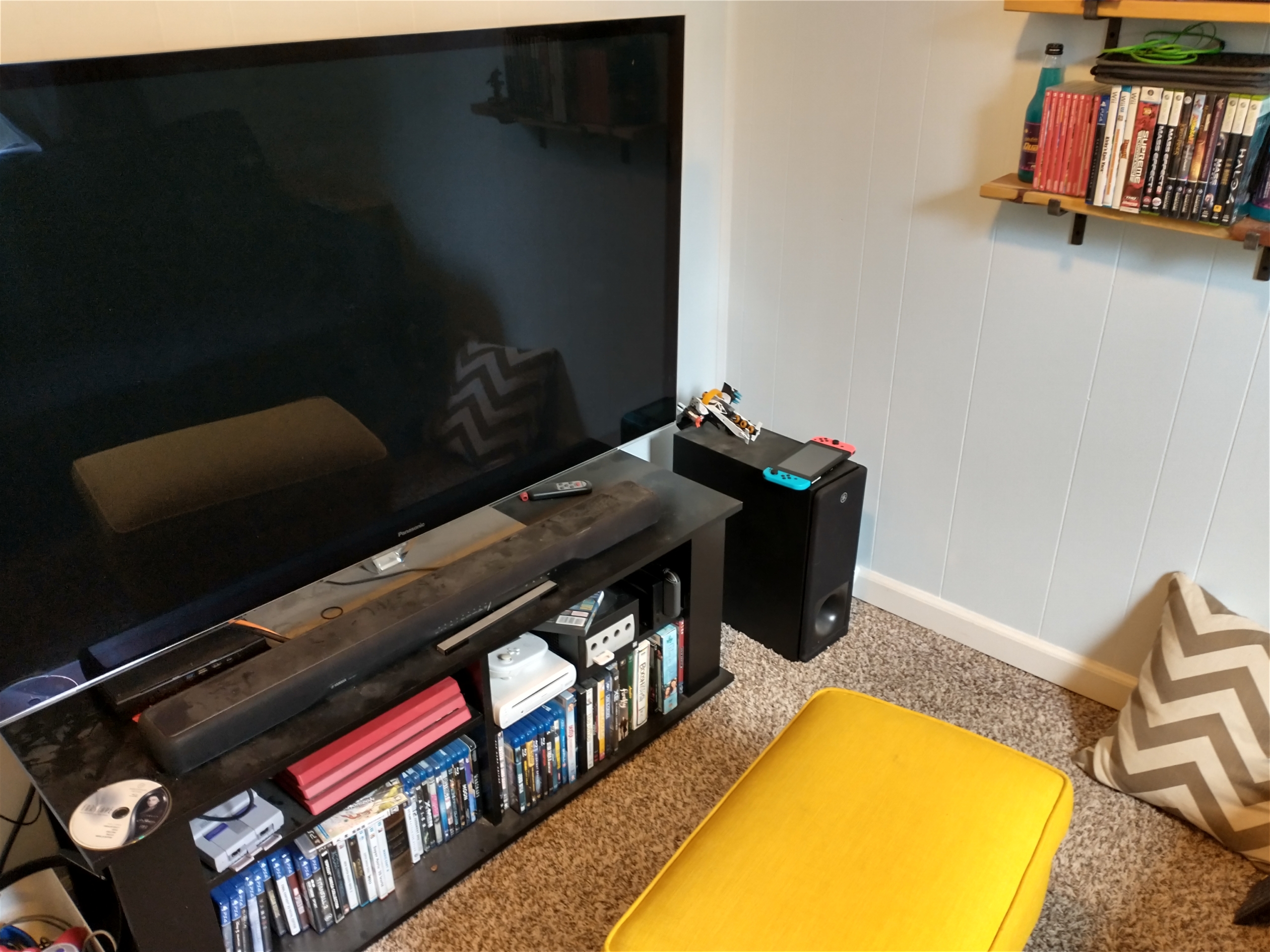“The long-lasting Moto G Power delivers on battery life, but it's too heavy for most buyers.”
- Two to three days of battery life
- Nice display for budget phone
- Feels solid, durable
- Ultrawide camera is fun to use
- Heavy and thick
- No NFC for Google Pay
- Main camera is just OK
Want a budget Android phone? Motorola is likely to be your first stop. The veteran smartphone maker has two new releases, the Moto G Stylus and the Moto G Power, and each target very specific users.
They do what they say on the tin. The G Stylus has a stylus and the G Power, reviewed here, has power. Battery power. I know your kid might be looking over your shoulder, so let’s just call it a metric fudge-ton — 5,000mAh, to be exact.
That’s a lot! The iPhone 11 has a 3,110mAh battery, and the Google Pixel 4 XL has a 3,700mAh battery. A few phones, like the Asus ZenFone 6, do match the G Power’s battery size, but most don’t.
What makes the G Power exceptional is the price you pay for that battery. Motorola is selling this phone unlocked for $250. That snags you the huge battery, 4GB of RAM, and 64GB of internal storage (MicroSD cards up to 1TB can upgrade that figure). This is the only version available.
Is this long-lasting budget phone worthy of finding a place in your pocket? Let’s have a look.
Design and display
If you’ve ever slapped a battery case on a phone, you know the extra endurance comes at the price of added weight and a thicker profile. The Motorola Moto G Power bundles the battery inside, but it isn’t exempt from this problem.
The Moto G Power is 0.38 inches thick and weighs in at a touch over 7 ounces. The older Moto G7 Play is 0.31 inches thick and weighs only 5.3 ounces. Samsung’s Galaxy A50 is just 0.3 inches thick and weighs about 5.9 ounces.
So, as Twitter might say, the G Power is THICC.

You’ll feel that. It’s a hefty, substantial phone. On the plus side, this offers an aura of quality that’s not often found in budget phones. On the downside, it’s heavy. I noticed it most when holding the phone in bed, or when reclining on my sofa. My arm started to feel tired after a short while.
Yes, I’m a limp-wristed tech reviewer who couldn’t bench a fat housecat. Still, the added weight was annoying. I wouldn’t buy the phone for this reason alone. This isn’t a problem I want to deal with in an everyday device.
As Twitter might say, the G Power is THICC.
The G Power’s weight isn’t just due to its battery. It also packs a 6.4-inch display with a 19.17:9 aspect ratio. It’s a large display, though not uncommon for the category. Samsung’s Galaxy A50 and M30 both have 6.4-inch displays.
It’s an attractive screen, vibrant and bright enough to be usable on a sunny day. You’ll certainly see better contrast from OLED panel, and that’s a place Samsung’s most affordable devices can claim an undeniable victory. However, the Moto G Power’s display is solid, and I think most buyers will be impressed.
Flip it over, and you’ll find the Moto G Power clad in Motorola’s conservative new look. Moto used to be synonymous with quirky design (I bought, and loved, a blue-and-orange Moto G3), but the company’s more recent phones are more elegant and, frankly, boring. Like many new phones, the G Power is shiny, subtle, and refined, with a gloss black plastic back Moto obviously hopes you’ll mistake for glass at a distance.
A fingerprint reader is included for secure login. It’s quickly and rarely fails to read a fingerprint, as I’ve come to expect from similar readers on other devices.
Ports? You’re getting USB-C and a headphone jack. I’ve no complaints there. I do wish Motorola had made the phone water-resistant, however. It’s sold as “water repellent” but isn’t rated to be submerged at any depth for any duration. Don’t drop it in the toilet.
The Moto G Power’s design is fine. The display even has reasonably slim bezels. It’s a bit dull, and a step back from Moto’s more ambitious earlier phones, but I get it. People want to buy budget phones that look like expensive phones. From that standpoint, the Moto G Power’s design succeeds.
Battery life
The Moto G Power is all about battery life. It has 5,000mAh of juice, to be exact, and Motorola promises up to 72 hours of battery life.
That would have appeared outlandish a few years ago. Today, it’s still a lot, but not unheard of. The Asus ZenFone 6, Samsung Galaxy M30, and Samsung Galaxy S20 Ultra all have batteries of similar size, though their endurance claims aren’t as extreme.
It’s an impressive battery for the price, to be sure. While the Galaxy M30 can be found at low prices on Amazon, the ZenFone 6 is $500 and the Galaxy S20 Ultra is “how much ya got?” The large battery is a standout feature.
The battery endured two full days, and some of a third.
I used the Moto G Power lightly in my first week with the phone, as I focused my attention on the Moto G Stylus. The battery lasted for five days. After I switched to primarily using the G Power, the battery still endured two full days, and some of a third. I’ll admit I’m not the most demanding user. Still, this is an outstanding result.
In fact, it’s overkill. I don’t think charging a phone overnight is a hassle, so I think a battery that can handle a day of heavy use is adequate. Most modern phones can achieve that. The Moto G Power might last two, but I must ask. What’s the point? Why put up with a heavier, thicker phone all day, every day?
If your answer is “well, I need this because of …” then sure. I get that. The Moto G Power deserves recognition for bringing extreme endurance to a low price point. But let’s be real. This is a niche device. It’s built for people who want to use a phone a lot, yet also don’t want to spend much on it.
Performance
The Moto G Power has a Qualcomm Snapdragon 665 octa-core processor and Qualcomm Adreno 610 GPU. This is a go-to option for a budget phone sold in 2020.
Performance usually isn’t an issue. Most applications launch in the blink of an eye and run well while active. And while the phone’s 4GB of RAM might look just OK on paper, I never ran into issues while swiping between applications.
Here’s how the Moto G Power managed in benchmarks
- Geekbench 5: 312 single-core, 1388 multi-core
- 3DMark Sling Shot Extreme (Vulkan): 1,133
The Geekbench 5 score delivers a modest improvement over last year’s budget phones. A Moto G7 scores 268 in single-core and 1,183 in multi-core. The Sling Shot Extreme result is a huge upgrade over the older Moto G7, which only hit 543 when we tested it last year. Samsung’s Galaxy A50, also now a year old, beats the Moto G Power with a score of 1,368 in 3DMark’s Sling Shot Extreme.
I only noticed the Moto G Power’s limits when rapidly scrolling through long lists of content, such as news feeds or podcasts, or when visiting websites that go hard on (frankly rather intrusive) elements, like pop-up video players or extensive animations. An occasional jerk or moment of pause was evident in these situations. Even the fastest phones can struggle here, but I think the Motorola G Power feels considerably less fluid than, say, a Google Pixel 4, which shipped late last year with a Snapdragon 855.
Still, obsessing over the Moto G Power’s performance a bit silly. Modern smartphones, like laptops sold ten years ago, are now fast enough for most people most of the time. I had no problem using the Moto G Power every day. Is a Google Pixel 4 or iPhone 11 quicker? Yes. But you can easily get by with the G Power (or another phone powered by this SoC).
Obsessing over the Moto G Power’s performance a bit silly.
Gaming is a mixed bag. Most mobile games are designed to run on a wide variety of phones and won’t push a phone like the Moto G Power hard. Even Call of Duty: Mobile and SimCity BuildIt ran well enough that I didn’t notice any hesitation. Demanding games like Injustice 2 and Asphalt 9 were another story. These were playable on the Moto G Power, but occasionally stuttered, and rendered at a framerate that was noticeably below 30 frames per second.
It’s important to know the G Power does not have NFC, which means it does not support Google Pay. This is an unfortunate omission almost certainly done to keep the price down, but contactless payment is always helpful — and even recommended in these social distancing days — and it’s missed here.
Audio quality
Stereo speakers “tuned by Dolby” are located on each side of the phone (when held horizontally). One speaker is above the display, with the other on the phone’s lower lip. That means audio is stronger on one side than the other. It’s noticeable, but not annoying.
The audio is loud and clear. There’s not much bass, and the maximum volume is short of what flagship phones can produce, but it’s enough to keep you entertained in a room with little to no ambient noise. Audiophiles will want to pack headphones, earbuds, or a Bluetooth speaker.
Camera quality
Despite its price tag, the Moto G Power does its best to emulate the camera features of more expensive competitors. It comes with a 16MP main rear camera, an 8MP ultrawide with a 118-degree field of view, and a 2MP Macro camera. There’s also a 16MP front-facing camera.
To me, the 8MP ultrawide is the standout feature. It’s uncommon in budget phones and adds a ton of versatility. You can use this camera for more convincing landscape shots or to better capture a tight space. The camera delivers subdued color and struggles to handle extreme lighting, but a decent smartphone photographer could use it for some outstanding shots. Plus, it’s fun to goof off with it.
The 16MP main camera is what I’d expect from a budget smartphone in 2020. It takes neutral, balanced shots that often lack the vibrancy and sharpness you’ll find in the best phone cameras. Quality is best in excellent lighting and falls off noticeably in dim situations, but excellent lighting can also throw off the color balance, leaving you to futz around with the rather touchy manual controls.
While the main camera didn’t set my hair on fire, I should remark it’s a massive step up over budget phones sold just a few years ago. The Moto G Power’s main camera can be used for great photos if you have some skill.
The 2MP Macro shares difficulties common to other smartphones with this option. The ability to zoom in on a subject is balanced by reduced sharpness, poor low-light performance, and issues with color balance. Frankly, I’m not sure most macro shots look better with the 2MP Macro camera engaged. The macro mode does work when very, very close to very small objects, but how often do you take photos like that? I’m not sure I ever do.
What about the 4MP (quad pixel) selfie camera? It works well enough. Quality is dependent on lighting, but if you have the right angle, your shots can look great. I’m annoyed by the off-set camera location, however. It’s in the phone’s upper left corner, not the middle, which makes finding the best angle less intuitive.
Video quality
The Moto G Power’s main camera is capable of capturing 4K video up to 30 frames per second (fps), or 1080p video up to 60 fps. Slow-motion video can capture up to 120 frames per second at 1080p, or 240 fps at 720p.
This is solid for a budget phone, though you shouldn’t plan to use anything aside from 1080p frequently. 4K video can look sharp in ideal lighting, but quickly falls apart in more demanding situations. The same can be said for slow-motion.
If you do stick to 1080p, you can expect a sharp image with a generally neutral color balance that, like photos taken with the main camera, struggles to cope with very dim or excessively bright situations. Keeping budget in mind, though, I think the Moto G Power’s video is solid.
Software
The Moto G Power has a lightly skinned version of Android 10. My unlocked review unit came with no bloatware of note, unless you count the slim and mostly unnecessary Moto and Moto Audio apps. Like past Motorola smartphones, the G Power greets you with a cheerful “Hello Moto” when you turn it on.
Moto Actions make their return. They let you activate certain features with specific gestures. For example, you can activate the camera by twisting your wrist twice, or turn on the flashlight with two swift chopping motions. Moto Actions are convenient and fun to use.
The camera app is Motorola’s one software misfire. It has a finicky look with tiny control icons at the top of the app, and a capture button designed to look like a camera shutter. Placed next to a Google Pixel 3a, the difference is night and day, and not at all in the G Power’s favor.
Price, warranty, and availability
The Motorola G Power costs $250 and will be released in April. You can order one directly from Motorola’s website, and it will also be sold through Verizon, Republic Wireless, US Cellular, and Google Fi. Confusingly if you live in Europe, Motorola has launched the G8 Power instead of the G Power. It’s almost identical in every way to the G Power but with an additional 8-megapixel telephoto camera onboard. It costs 220 British pounds, or about $270.
Motorola provides a one-year warranty on its phones in the U.S., and buyers can also purchase an additional MotoCare plan to cover water and accidental damage. Prices vary from $23 to $64 for a year, depending on the cover required.
Our take
The Moto G Power is a fine phone sold at an obtainable price, but it’s niche by nature. I don’t think the crossover between “power users who need multiday battery life” and “budget phone buyers” is broad.
Is there a better alternative?
Yes, but you will have to pay more. Unless your budget is incredibly tight, it’s worth spending more on a phone because it will remain usable for longer, regardless of whether your usage changes. If you can stretch to $400, the Google Pixel 3a is excellent, with a great camera and guaranteed software updates for several years. Spend $500, and the Asus Zenfone 6 is a superb buy, with its close-to-flagship specs and a fun flip camera.
If under $300 is all you want to spend, then shop around and try to get the Samsung Galaxy A51 for that price. The international version, compatible with GSM networks, often turns up on Amazon for less than $300. Samsung also announced the new Galaxy A21, which will sell for $250. We’ve yet to have hands on it.
If Motorola is your brand of choice, you can check out the Moto G Stylus, but it’s only slightly lighter.
Finally, here’s my pro tip. Just wait to see what Google does with the rumored Pixel 4a, expected in the coming weeks. It’s sure to be desirable, and even if it’s still out of your budget, the still excellent Pixel 3a may get significant price cuts. Additionally, Apple is expected to show the iPhone SE 2/iPhone 9 soon, which may be affordable at around $400. Also, it’s worth seeing how long it takes for HMD Global’s Nokia 5.3 to make it to the U.S. after April, at which time it launches in Europe for $205
How long will it last?
The G Power does not have a water-resistant body, but it is made of plastic, so it should be slightly better off in a fall than one made of glass. However, it’s not a “tough” phone.
Budget Android phones also have a short lifespan because they don’t receive the latest Android updates quickly, or at all. Motorola’s Android update schedules are messy. The Moto G Power is promised to receive on OS upgrade and frequent security updates. Better support would be excellent, but this is typical for an Android phone in this price bracket.
Should you buy one?
No. The Moto G Power fits a specific niche of cash-strapped power users, but it’s too heavy and thick for most people.












